How to fix the bathroom sink to the wall: a detailed instruction on how to fix it
Modern wall-mounted sinks are one of the main elements of the combined bathrooms and bathrooms. They differ from the models built into the countertop in the way of fastening.
We will tell you how to fix the sink in the bathroom to the wall in order to maintain the integrity of the bowl. We will also show you how to ensure the reliability of fixation and comfort during the operation of plumbing. Based on our recommendations, you can easily do all the work yourself.
The content of the article:
Varieties of Wall Sinks
As early as the middle of the last century, almost all modifications of wall-mounted models were reduced to one type - a bowl mounted on two cast-iron brackets. Metal supports remained visible and did not look very aesthetically pleasing.
With the development of the plumbing industry, many new models have appeared that have a hidden method of fastening, are distinguished by an elegant design and durability. There are several classifications of wall-mounted washbasins, depending on the fasteners used, the shape or material of the bowl.
The so-called "tulips" or pedestal sinks also apply to wall models, but have additional supports that simultaneously mask the siphon and pipes. Furniture sets with a sink in the countertop are popular, and both the bowl itself and the hanging cabinet can be attached to the wall.
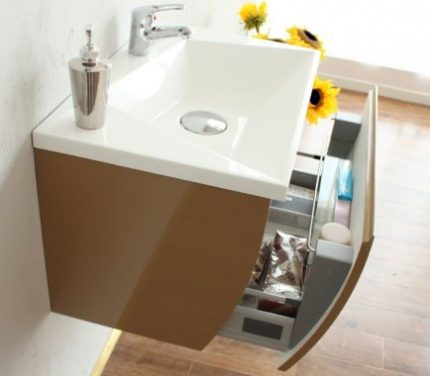
Convenient bowls built into the countertop. The countertop, in turn, is also fixed to the wall, and not mounted on the floor.
Thus, the area under the sink remains completely free, which is convenient for cleaning and just for washing. However, more practical residents are installed under the sink, or small washing machine, or a small whatnot for sanitary accessories.
The most popular are ceramic models. But when choosing, you should remember that earthenware models are simpler and cheaper, while porcelain models look more attractive, but are notable for their high price.
For bathrooms with a deficit of free space compact corner models without extra entourage. Unlike the front ones, they do not require a free wall and easily fit in a niche or corner with a wall width of 0.3 m.
Step-by-step instructions for mounting
The mounting method depends on the model of the washbasin. For example, the installation of a single porcelain sink differs from the installation of a plumbing fixture built into a hanging countertop, although both options are attached to the wall.
Today, the most common is the method of mounting on brackets, which are studs or screws screwed into the wall. Below is a detailed guide for attaching a ceramic sink to a wall in the bathroom.
Stage # 1 - preparatory work
Preparation involves the purchase of a plumbing fixture, mixer, drain kit, as well as checking the reliability of the wall.
First you need to make sure that the wall will stand your chosen sink. In modern apartments, redevelopments are often carried out or false walls are erected, as a result of which instead of a supporting wall, gypsum cardboard may appear under ceramic tiles.
If the base is weak, you will have to partially disassemble the wall and install mortgages - for example, metal guides, installation for hanging plumbing or wooden blocks.
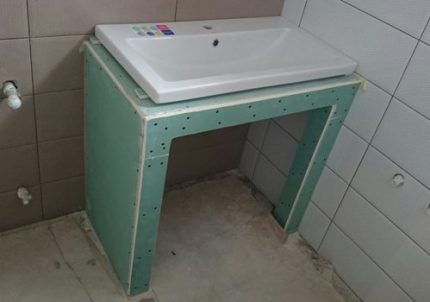
In order not to be distracted during the installation process, you need to prepare a set of tools. You will need a drill or punch for punching holes, an adjustable wrench or a set of open-end wrenches in size, level, construction tape measure or a long metal ruler, marker. Plumbing sealant is also necessary, in some cases special glue.
Stage # 2 - marking on the wall
Proper markup is half the battle. If the holes are not accurately drilled, lining replacement may be required. It is not difficult to buy a plastic panel, however, ceramic collection tiles will cost much more, there is a risk of not finding it on sale.
Therefore, you need to determine exactly installation height (85-90 cm) and measure the distance between the holes for mounting. The necessary numbers are indicated in the instructions that complete the new plumbing product.
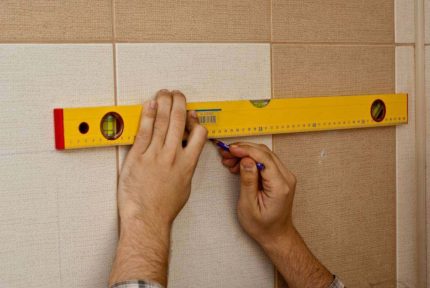
We take the dimensions from the bowl or find the desired values on the diagram, then transfer them to the wall. Places for holes are marked with a marker.
It’s sometimes easier to make a trial installation of a sanitary appliance: this is usually done with tulip shells and models with hanging cabinets or countertops.We make sure that the communication holes are in close proximity.
Stage # 3 - drilling holes
This stage is associated with the difficulty of drilling revetted walls. To perform a seemingly simple operation, experience is needed, otherwise the tile will simply crack. The fact is that for drilling tiles and foundations (concrete, brick), different drills and different operating modes are required. Masters also use one tool, but not everyone succeeds.
To prevent the drill from slipping and entering the tile evenly, it is necessary to use a core. Put it to the drilling point and gently hit it with a hammer several times.
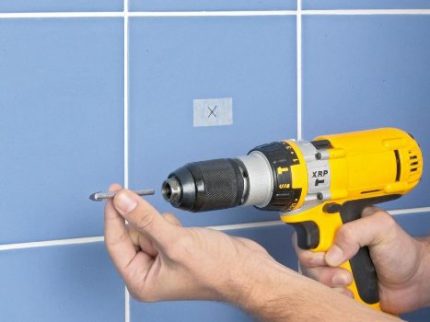
Next, the drill can be changed to a punch and continue to work - drilling holes in the wall. The diameter of the core drill is 12 mm. The minimum mounting bracket depth is 5 cm, but the exact data must be clarified in the instructions. We clean the finished holes using improvised materials or a vacuum cleaner.
Stage # 4 - fixing the fasteners to the wall
Sink holders are anchor bolts perpendicular to the wall. So that they fit tightly and do not stagger, plastic plugs or devices such as dowels are inserted into the holes.
Often fasteners are included with the new product, so nothing needs to be selected. Gently screw the metal rods into the holes so that the ends of the required length remain outside.
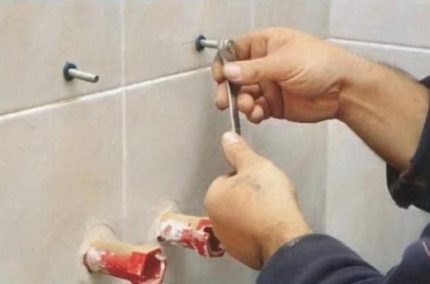
Sometimes there are problems with fixing anchors. The main reason is a crack or seam in the base under the tile. To get rid of the defect, you can try to concrete the gap, and then carefully drill a hole in it. But there is an easier way - to fill the cavity with epoxy glue, and then immediately insert a bolt into the hole so that it fixes better.
Stage # 5 - Installing the Sink Bowl
The final stage fixing the sink to the wall It happens easily: the sink is simply strung on anchor bolts and pressed as tightly as possible against the wall. Then we take the nuts with gaskets and twist them on the remaining free ends of the pins.
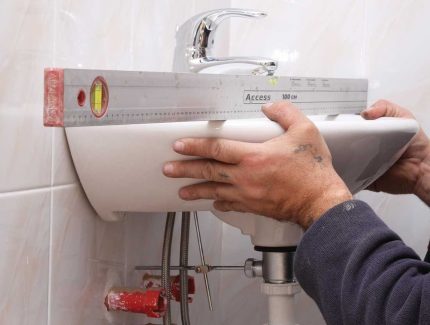
When the nuts are tightened, the sink is pressed and glued. The positive point is a stronger mount, the negative is the difficulty with replacing equipment in the future. If you need to remove the sink for more convenient installation of the mixer or siphon, this will also be impossible.
Installing the model on the studs is not the final step. It is also necessary to connect a drainage system with a water lock and a mixer, if it is installed on the sink, and not on the wall.
The sequence of events can proceed in different ways: often, for ease of installation, all devices are installed first, and then the sink is already mounted. At the finish, it remains only to connect the hoses.
How to install the mixer?
The most successful option is to install the device before installing the sink. The bowl is set in a comfortable position and produced mixer mounting in a specially designed hole on the bowl shelf.
The installation process does not depend on the design of the mixer: lever and valve models are installed according to one sample. Connection to the water supply also occurs in the same way. Flexible hoses the mixer is connected to the outlet openings of the hot water and cold water pipes, then the nuts are tightened. The joints are sealed if necessary.
An important nuance: before connecting the communications, it should be clarified which side is cold / hot water. If the mixer is installed correctly, then its supply for cold water is on the right, and for hot water on the left.
The final touch is testing. It is better to carry it out after connecting the drain device and with the aerator removed - so as not to spoil it with debris that accidentally gets into the network during repair.
Drain device connection
A drain device is a plastic or metal water trap with nozzles or a corrugated hose. Consider installing the popular bottle model, which is easy to install, and if clogging occurs, it is quickly and easily cleaned.
An important final point - check drain system for tightness. At the same time, you can check the operation of the mixer. We plug the drain valve with a stopper, wait for the sink to fill, and watch how the water goes through the overflow.
Then we take out the cork and in the same way we check whether the siphon is leaking. If no leaks are observed, the installation process of the drain is considered complete.
Conclusions and useful video on the topic
Much of the installation process depends on the model of the sanitary fixture for the bathroom. To find out the details, we suggest getting to know more about different solutions.
Video # 1. How to install a wall-mounted tulip model:
Video # 2. Installation of a block of suspended structures - sinks, cabinets and cabinet:
Video # 3. Step-by-step installation instructions for the front model:
The installation of the sink in the bathroom belongs to the category of lungs, so they can be done independently. Simplifies the process and the fact that you do not need a special tool, just a traditional home set.
Once you attach the sink to the wall, installing a mixer and a water lock, you can independently repair or replace equipment in the future.
Please write comments, post photos, ask questions in the block below. Tell us how you bought and installed the sink in your own bathroom. It is possible that in your arsenal there are technological subtleties that will be useful to site visitors.

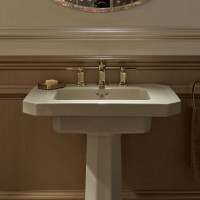 How to install a tulip shell on your own: phased instruction
How to install a tulip shell on your own: phased instruction 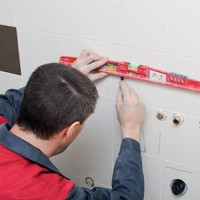 How to properly mount the sink to the wall: step-by-step instruction
How to properly mount the sink to the wall: step-by-step instruction 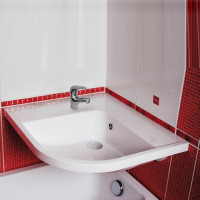 Hanging bathroom sink: step-by-step installation instructions
Hanging bathroom sink: step-by-step installation instructions 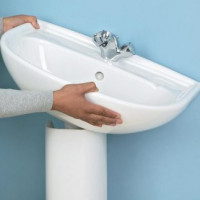 How to install a sink with a pedestal: step-by-step installation instructions
How to install a sink with a pedestal: step-by-step installation instructions 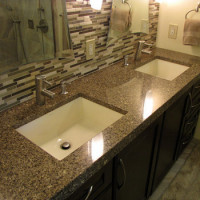 Countertop for the bathroom under the sink: types, how to choose and install correctly
Countertop for the bathroom under the sink: types, how to choose and install correctly 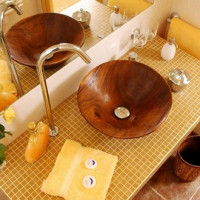 Installing a sink in the bathroom: installation instructions for modern models
Installing a sink in the bathroom: installation instructions for modern models  How much does it cost to connect gas to a private house: the price of organizing gas supply
How much does it cost to connect gas to a private house: the price of organizing gas supply  The best washing machines with dryer: model rating and customer tips
The best washing machines with dryer: model rating and customer tips  What is the color temperature of light and the nuances of choosing the temperature of the lamps to suit your needs
What is the color temperature of light and the nuances of choosing the temperature of the lamps to suit your needs  Replacement of a geyser in an apartment: replacement paperwork + basic norms and requirements
Replacement of a geyser in an apartment: replacement paperwork + basic norms and requirements
Such work does not cause difficulties in itself: the design of the mounts is very simple, everything is thought out for our convenience. But the preparatory work is painstaking, requires attention and patience. The most difficult thing for me is drilling. If you can align the sink with the help of a level with minimal experience, then drilling a tile so that it does not crack is already a big risk.